Assessment of Wetland Ecosystem Health Using the Pressure–State–Response (PSR) Model: A Case Study of Mursidabad District of West Bengal (India)
Abstract
:1. Introduction
2. Materials and Methods
2.1. Study Area
2.2. Data and Methods
2.2.1. Data Resources and Processing
2.2.2. Assessment of Wetland Ecosystems Health
2.2.3. Wetland Classification
2.2.4. Indicator System Establishment
2.2.5. Determination of Indicator Weights and Assessment Methods
3. Results
3.1. Wetland Ecosystem Pressure
3.2. Wetland Ecosystem Health State
3.3. Wetland Ecosystem Health Response
3.4. Spatial-Temporal Variations and Levels in the Health Status of Wetland Ecosystem
4. Discussion
5. Conclusions
Author Contributions
Funding
Conflicts of Interest
References
- Keddy, P.A. Wetland Ecology Principles and Conservation; Cambridge University Press: Cambridge, UK, 2000; pp. 124–238. [Google Scholar]
- Chen, Z.; Shang, H.; Yao, B. Methods of wetlands health assessment in USA. Acta Ecol. Sin. 2009, 29, 5015–5022. [Google Scholar]
- Foote, L.A.; Pandey, S.; Krogman, T.N. Processes of wetland in India. Environmental conservation. Environ. Conserv. 1996, 23, 45–54. [Google Scholar] [CrossRef]
- Leopold, A. Wilderness as a land laboratory. Living Wilderness 1941, 6, 287–289. [Google Scholar]
- Rapport, D.J.; Regier, H.A.; Thorpe, C. Ecosystem behaviour under stress. Am. Nat. 1985, 125, 617–640. [Google Scholar] [CrossRef]
- Brown, M.T.; Vivas, M.B. Landscape development intensity index. Environ. Monit. Assess. 2005, 101, 289–309. [Google Scholar] [CrossRef] [PubMed]
- Gu, D.; Zhang, Y.; Fu, J.; Zhang, Z. The landscape pattern characteristics of coastal wetlands in Jiaozhou Bay under the impact of human activities. Environ. Monit. Assess. 2007, 124, 361–370. [Google Scholar] [CrossRef]
- Veselka, E.W.; Anderson, T.J. Wetland Indices of biological integrity. Wetl. Tech. 2013, 3, 1–27. [Google Scholar] [CrossRef]
- Cole, A.C.; Brooks, P.R.; Wardrop, H.D. Wetland hydrology as a function of hydrogeomorphic (HGM) subclass. Wetlands 1997, 17, 456–467. [Google Scholar] [CrossRef]
- Mcallister, S.L.; Peniston, E.B.; Leibowitz, G.; Abbruzzese, B.; Hyman, B.J. A synoptic assessment for prioritizing wetlands restoration efforts to optimize flood attenuation. Wetlands 2000, 20, 70–83. [Google Scholar] [CrossRef]
- Abbruzzese, B.; Leibowitz, G.S. A synoptic approach for assessing cumulative impacts to wetlands. Environ. Manag. 1997, 21, 457–475. [Google Scholar] [CrossRef]
- Wu, C.; Chen, W.; Cao, C.; Tian, R.; Liu, D.; Bao, D. Diagnosis of wetland ecosystem health in the Zoige wetland Sichuan of China. Wetl. J. 2017. [Google Scholar] [CrossRef]
- Shil, S.; Singh, K. Health risk assessment and spatial variations of dissolved heavy metal and metalloids in a tropical river basin system. Ecol. Indic. 2019, 106, 1–12. [Google Scholar] [CrossRef]
- Albert, D.A.; Minc, L.D. Plants as regional indicators of Great Lakes coastal wetland health. Aquat. Ecosyst. Health Manag. 2004, 7, 233–247. [Google Scholar] [CrossRef]
- Dixon, H.; Das, L.; Allan, R.; Kangabam, R. Ecosystem service assessment of selected wetlands of Kolkata and the Indian Gangetic Delta: Multi-beneficial systems under differentiated management stress. Wetl. Ecol. Manag. 2019, 27, 405–426. [Google Scholar]
- Bornette, G.; Amoros, C.; Piegay, H.; Tachet, J.; Hein, T. Ecological complexity of wetlands within a river landscape. Biol. Conserv. 1998, 85, 35–45. [Google Scholar] [CrossRef]
- Péron, G.; Ferrand, Y.; Leray, G.; Gimenez, O. Waterbird demography as indicator of wetland health: The French-wintering common snipe population. Biol. Conserv. 2013, 164, 123–128. [Google Scholar] [CrossRef]
- Ogden, J.C.; Baldwin, J.D.; Bass, O.L.; Browder, J.A.; Cook, M.I.; Frederick, P.C.; Frezza, P.E.; Galvez, R.A.; Hodgson, A.B.; Meyer, K.D. Water-birds as indicators of ecosystem health in the coastal marine habitats of southern Florida:1. Selection and justification for a suite of indicator species. Ecol. Indic. 2014, 44, 148–163. [Google Scholar] [CrossRef]
- Kangabam, D.R.; Bhoominathan, D.S.; Kanagaraj, S.; Govindaraju, M. Development of water quality index (WQI) for Loktak Lake in India. Appl. Water Sci. 2017, 7, 2907–2918. [Google Scholar] [CrossRef] [Green Version]
- Sun, R.; Yao, P.; Wang, W.; Yue, B.; Liu, G. Assessment of wetland ecosystem health in the Yangtze and Amazon River Basins. Int. J. Geo Inf. 2017, 6, 81. [Google Scholar] [CrossRef] [Green Version]
- Jia, H.; Pan, D.; Zhang, W. Health assessment of wetlands ecosystems in the Heilongjiang river basin, China. Wetlands 2015, 35, 1185–1200. [Google Scholar] [CrossRef]
- Ministry of Environment and Forests (MoEF). Wetlands of India: A Directory; MoEF, Government of India: New Delhi, India, 1990.
- Ministry of Environmental Forests (MoEF). National Wetland Atlas: As a Part of the Project on National Wetland Inventory and Assessment (NWIA); Indian Space Research Organisation (ISRO): Ahmedabad, India, 2011.
- Das, T.R.; Pal, S. Investigation of the principal vectors of wetland loss in Barind tract of West Bengal. Geo J. 2017. [Google Scholar] [CrossRef]
- Das, S.; Behera, B.; Mishra, A. Determinants of household use of wetlands resources in West Bengal, India. Wetl. Ecol. Manag. 2015. [Google Scholar] [CrossRef]
- Iza, A. Developments under the Ramsar Convention: Allocation of Water for River for River and Wetlands Ecosystem. Reciel 2004, 13, 40–46. [Google Scholar] [CrossRef]
- Kuriqi, A.; Pinheiro, N.A.; Ward, S.A.; Garrote, L. Flow regime aspects in determining environmental flows and maximising energy production at run-of-river hydropower plants. Appl. Energy 2019, 256, 1–17. [Google Scholar] [CrossRef]
- Zhang, P.; He, L.; Fan, X.; Huo, P.; Liu, Y.; Zhang, T.; Pan, Y.; Yu, Z. Ecosystem Service value assessment and contribution factor analysis of land use change in Miyun in County, China. Sustainability 2015, 7, 7333–7356. [Google Scholar] [CrossRef] [Green Version]
- Rapport, D.J. What constitutes ecosystem health? Perspect. Biol. Med. 1989, 33, 120–132. [Google Scholar] [CrossRef]
- Mai, S.Z.; Xu, S.J.; Pan, Y.J. Application of the PSR model to the evaluation of wetland ecosystem health. Trop. Geogr. 2005, 25, 317–321. [Google Scholar]
- Mcfeeters, S.K. The use of the Normalized Difference Water Index (NDWI) in the delineation of open water features. Int. J. Remote Sens. 1996, 17, 1425–1432. [Google Scholar] [CrossRef]
- Jiang, W.G.; Li, J.; Li, J.H. Assessment of wetland ecosystem health in the Liaohe River Delta. Acta Ecol. Sin. 2005, 25, 408–414. [Google Scholar]
- Wang, Z.H.; Wang, K.L.; Xu, L.F. The assessment indicators of wetland ecosystem health. Territ. Nat. Resour. Study 2003, 4, 63–80. [Google Scholar]
- Sun, T.; Lin, W.; Chen, G.; Guo, P.; Zeng, Y. Wetland ecosystem health assessment through integrating remote sensing and inventory data with an assessment model for Hangzhou bay, China. Sci. Total Environ. 2016, 556–567, 627–640. [Google Scholar] [CrossRef] [PubMed]
- Sarma, P.; Das, D. Application of Shannon’s Index to study Diversity with Reference to Census Data of Assam. Asian J. Manag. Res. 2015, 5, 635–643. [Google Scholar]
- Ewers, M.R.; Didham, K.R.; Watten, D.S.; Tylianakis, M.J. Remotely sensed landscape heterogeneity as a rapid tool for assessing local biodiversity value in a highly modified New Zealand landscape. Biodivers. Conserv. 2005, 14, 1469–1485. [Google Scholar] [CrossRef]
- Malinowska, E.; Szumacher, I. Application of landscape metrics in the evaluation of geodiversity. Misc. Geogr. Reg. Stud. Dev. 2013, 17, 28–33. [Google Scholar] [CrossRef] [Green Version]
- Xie, G.; Lu, C.; Cheng, S. Progress in evaluating the global ecosystem services. Resour. Sci. 2001, 11, 5–9. [Google Scholar]
- Saaty, L.T. Decision making with the analytic hierarchy process. Int. J. Serv. 2008, 1, 83–98. [Google Scholar] [CrossRef] [Green Version]
- Saaty, T.L.; Vargas, L.G. The seven pillars of the analytic hierarchy process. Models, methods, concepts & applications of the analytic hierarchy process. Int. Series Oper. Res. Manag. Sci. 2012, 175, 23–40. [Google Scholar]
- Dechasa, F.; Senbeta, F.; Dirba, D. Determinants of household wetland resources use and management behaviour in the Central Rift Valley of Ethiopia. Environ. Sustain. 2019. [Google Scholar] [CrossRef]
- Liu, J.G.; Diamond, J. China’s environment in a globalizing world. Nature 2005, 435, 1179–1186. [Google Scholar] [CrossRef]
- Pal, S.; Akoma, C.O. Water Scarcity in Wetland Area within Kandi Block of West Bengal: A Hydro-Ecological Assessment. Ethiop. J. Environ. Stud. Manag. 2009, 2, 1–12. [Google Scholar] [CrossRef] [Green Version]
- Mondal, D.; Pal, S. Evolution of wetlands in lower reaches of Bagmari–Bansloi–Pagla rivers: A study using multi dated images and maps. Curr. Sci. 2017, 112, 2263–2272. [Google Scholar] [CrossRef]
- Biswas, B.; Ghosh, D.C.; Dasgupta, M.K.; Trivedi, N.; Timsina, J.; Dobermann, A. Integrated assessment of cropping systems in the Eastern Indo-Gangetic plain. Field Crops Res. 2006, 99, 35–47. [Google Scholar] [CrossRef]
- Mondal, D. Urban landuse change assessment using rs and gis: A case study of berhampore town and its surroundings, Murshidabad district, West Bengal. Geo Anal. 2012, 2. Available online: http://gswb.in/wp-content/uploads/2012/08/v2n1jully2012_4.pdf (accessed on 20 October 2019).
- Das, T.R.; Pal, S. Exploring geospatial changes of wetland in different hydrological paradigms using water presence frequency approach in Barind Tract of West Bengal. Spat. Inf. Res. 2017. [Google Scholar] [CrossRef]
- Sharma, S. Trend of urbanisation in berhampore municipality: A Geographical analysis. Geo Anal. 2012, 2, 49–56. [Google Scholar]
- Mistry, J.; Mukharjee, S. Status and threats of water birds in ahiran lake, Mursidabad, West Bengal, India. Int. J. Plant Anim. Environ. Sci. 2015, 5, 59–64. [Google Scholar]
- Baral, H.S.; Inskipp, C. Important Bird Areas in Nepal: Key Sites for Conservation. In Bird Conservation Nepal and Bird Life International; Kathmandu and Cambridge: London, UK, 2005. [Google Scholar]
- Datta, T. Human interference and avifaunal diversity of two wetlands of Jalpaiguri, West Bengal, India. J. Threat. Taxa 2011, 3, 2253–2262. [Google Scholar] [CrossRef] [Green Version]
- Horwitz, P.; Finlayson, C.M.; Weinstein, P. Healthy Wetlands, Healthy People. A Review of Wetlands and Human Health Interactions; Report No. 6; Ramsar Convention on Wetlands/World Health Organisation: Geneva, Switzerland, 2012. [Google Scholar]
- Sugunam, V.V.; Vinci, B.K.; Hassan, A.M. Ecology and Fisheries of Beels in West Bengal; Research Project; Central Inland Capture Fisheries Research Institute: Guwahati, India, 2000. [Google Scholar]
- O’Malley, L.S.S. Bengal District Gazetteers; Government of West Bengal: Murshidabad, India, 1997; pp. 22–24.
- Das, R.S.; Roy, M.; Khan, A.R.; Nandi, C.N. Ecology and Macrobenthic faunal diversity of some floodplain wetlands of River Ganga in West Bengal. Rec. Zool. Surv. India 2009, 109, 65–72. [Google Scholar]
- Wang, H.; Ge, Z.M.; Yuan, L.; Zhang, L.Q. Evaluation of the combined threat from sea-level rise and sedimentation reduction to the coastal wetlands in the Yangtze Estuary, China. Ecol. Eng. 2014, 71, 346–354. [Google Scholar] [CrossRef]
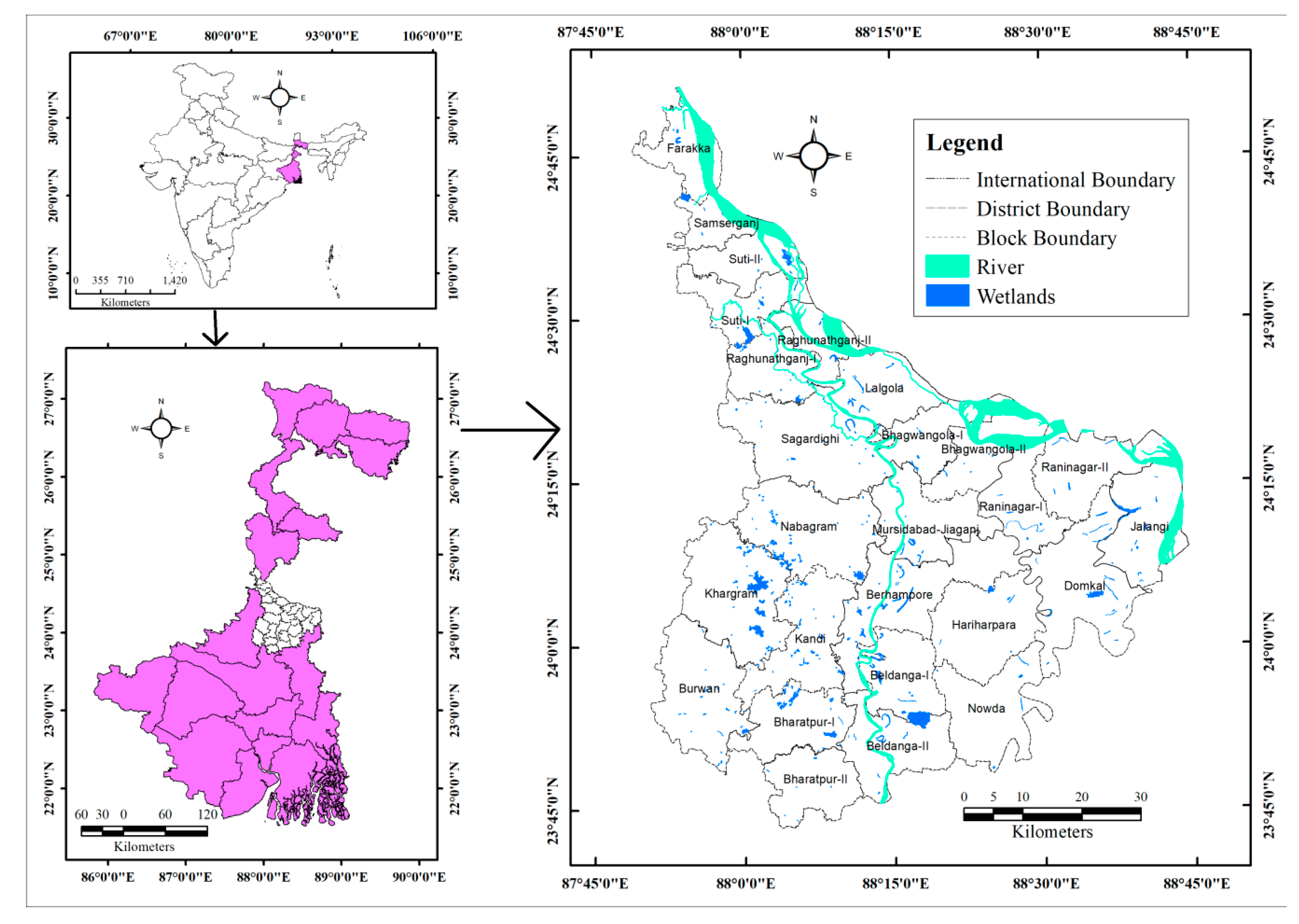
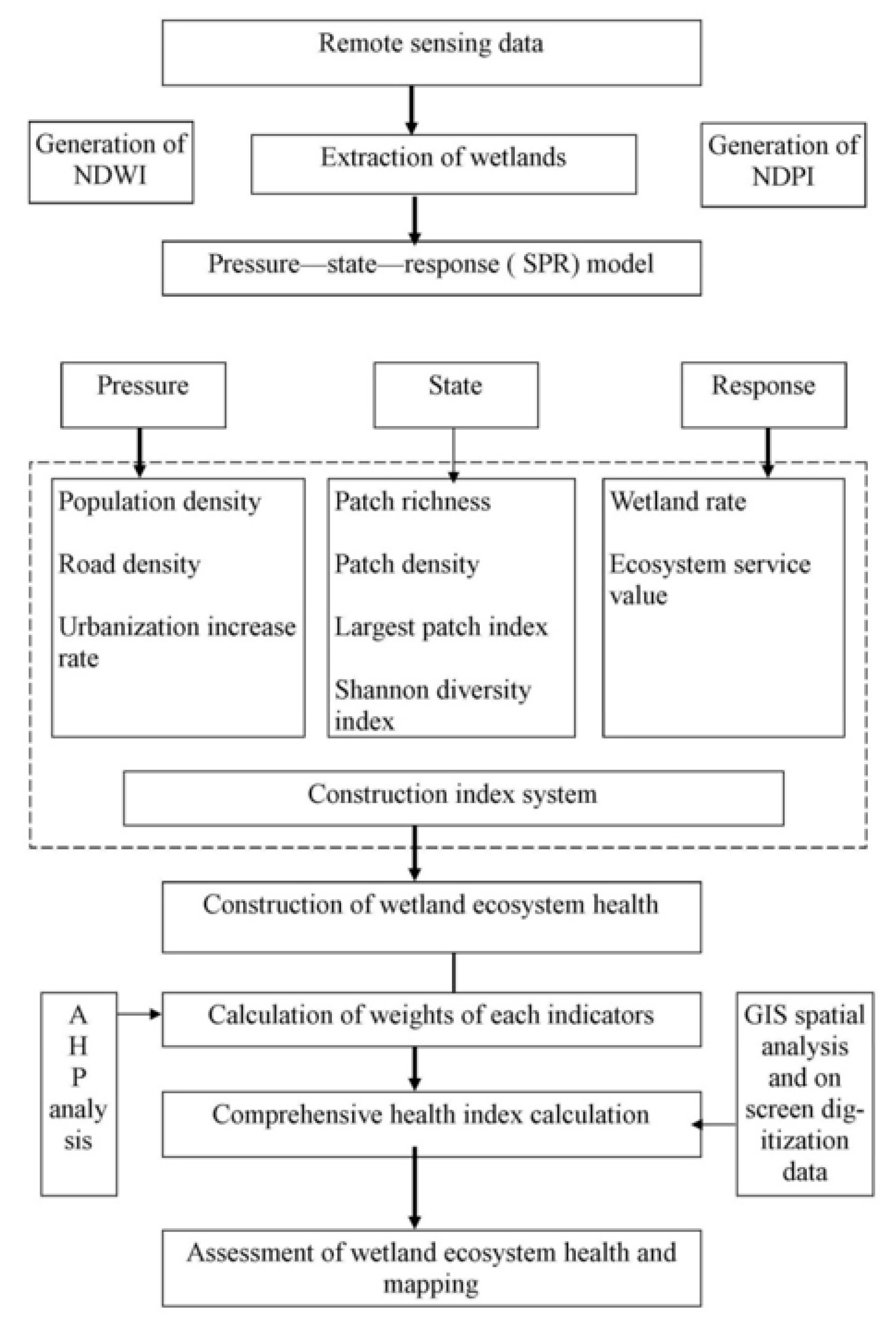

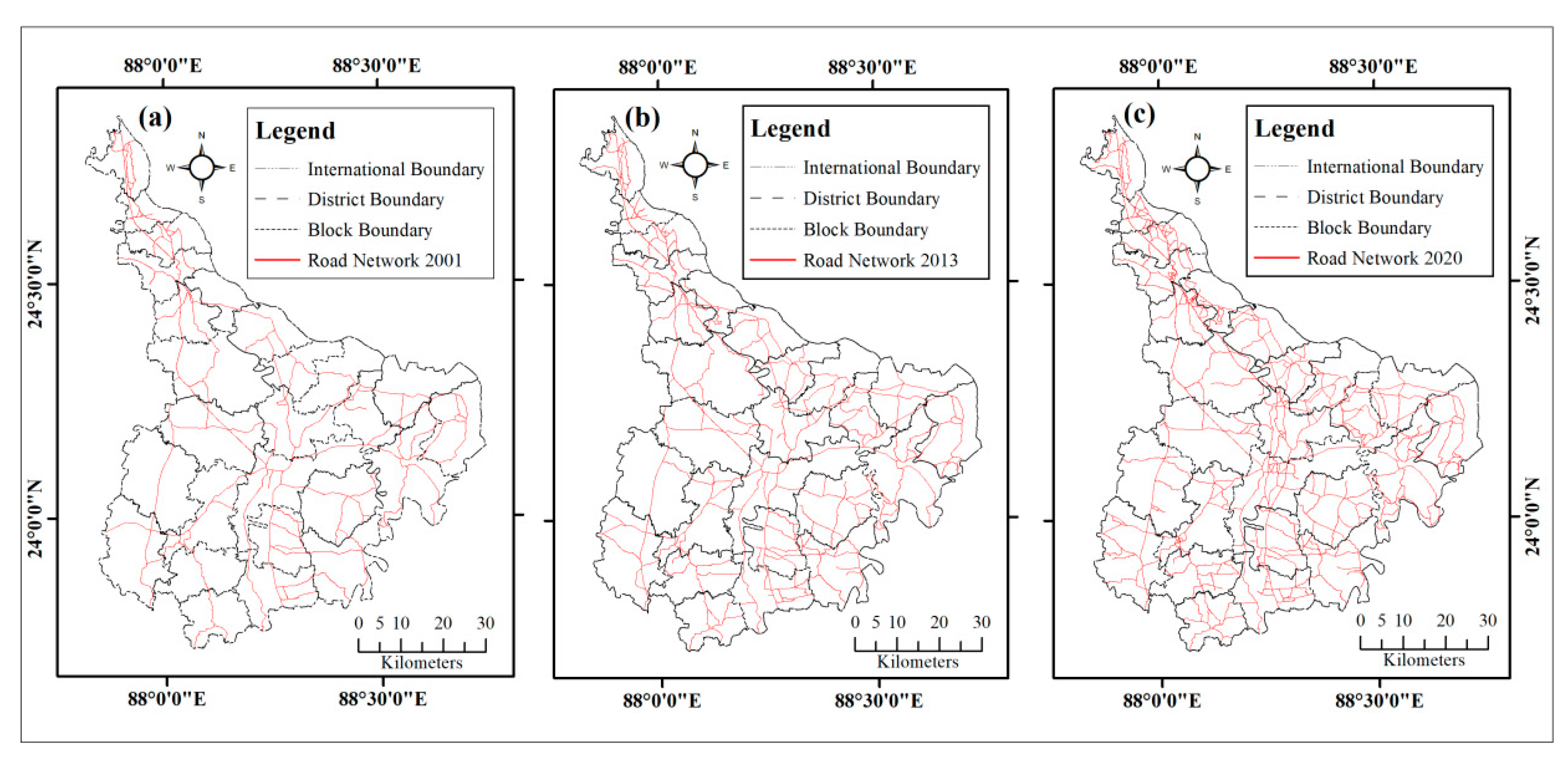
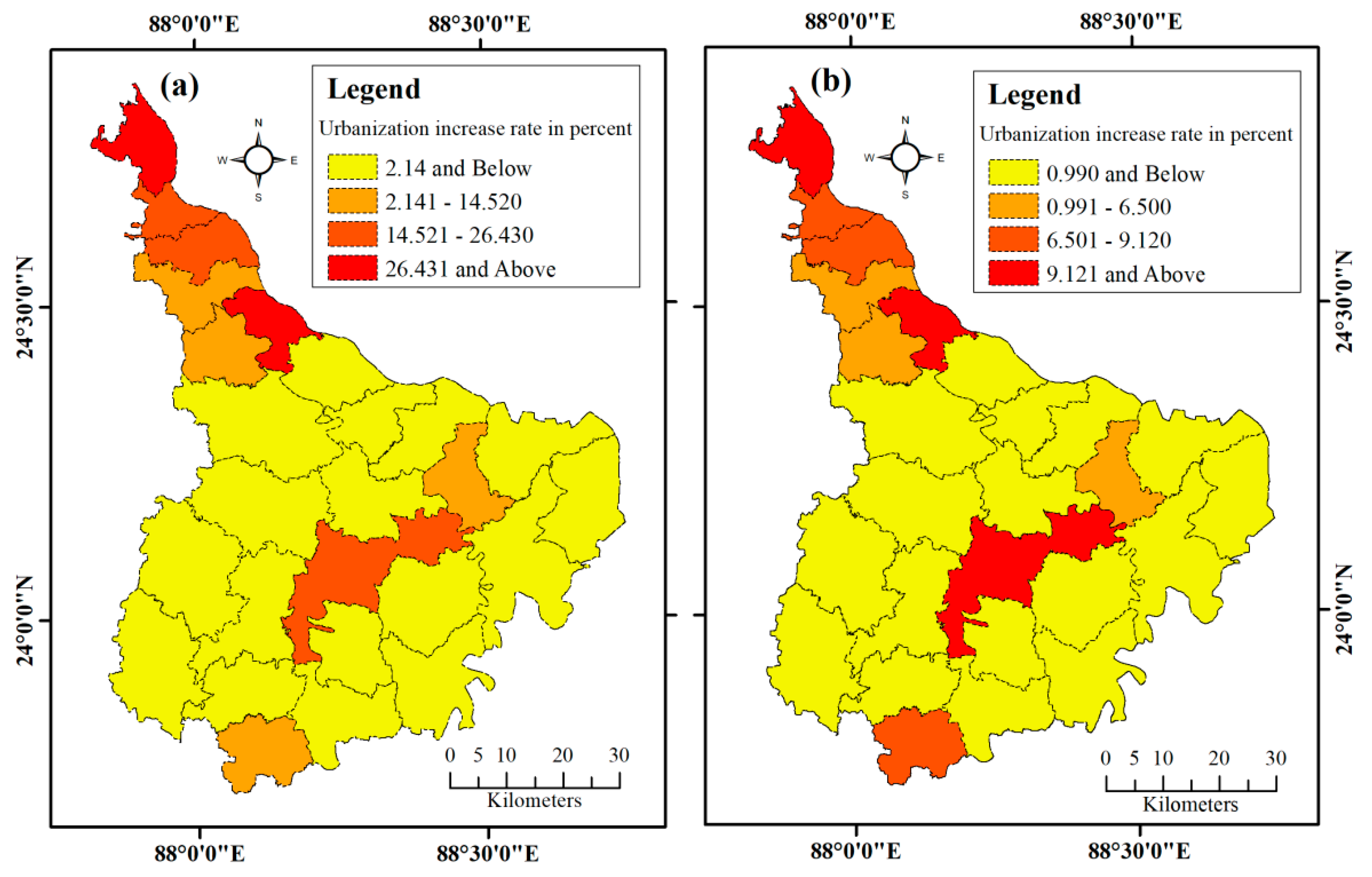
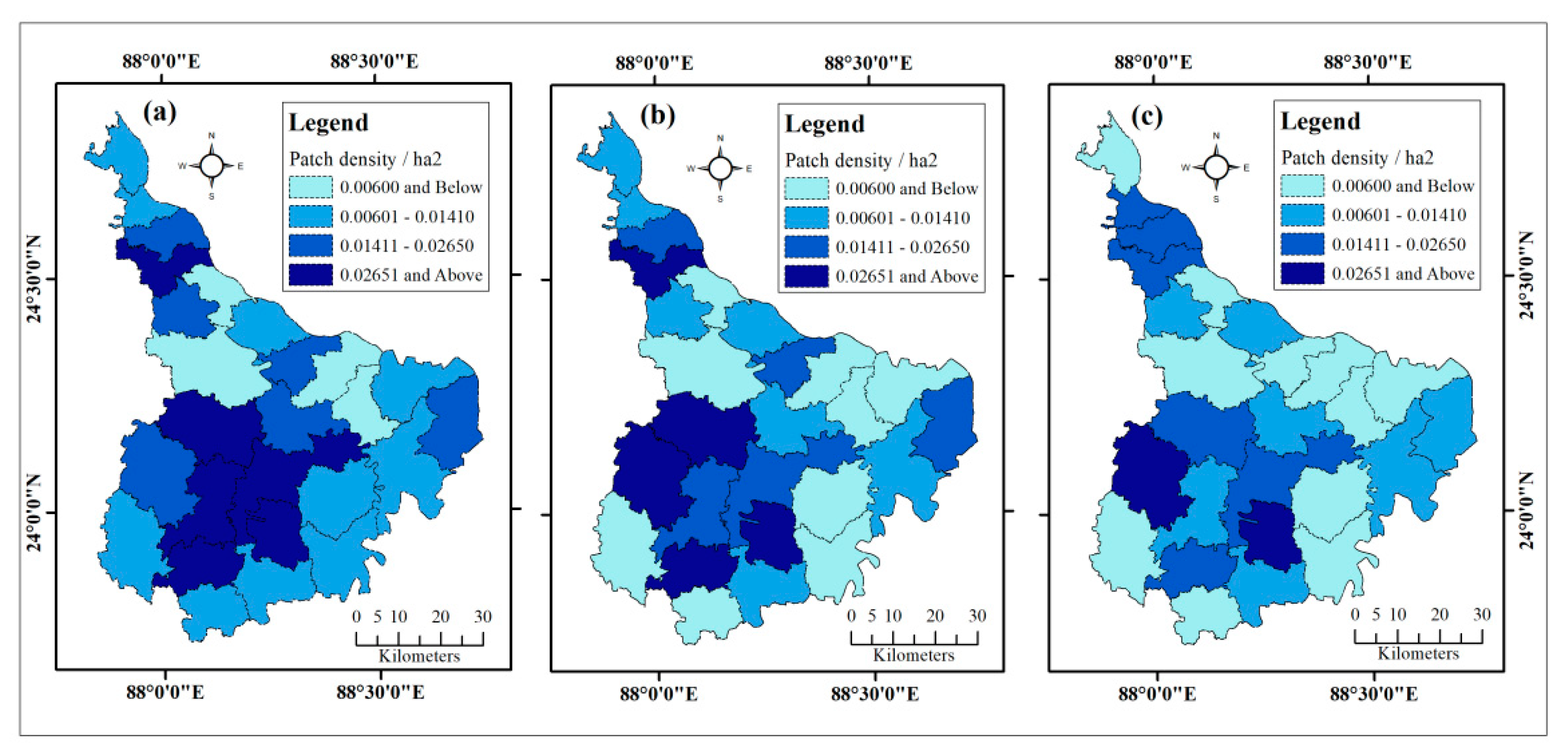
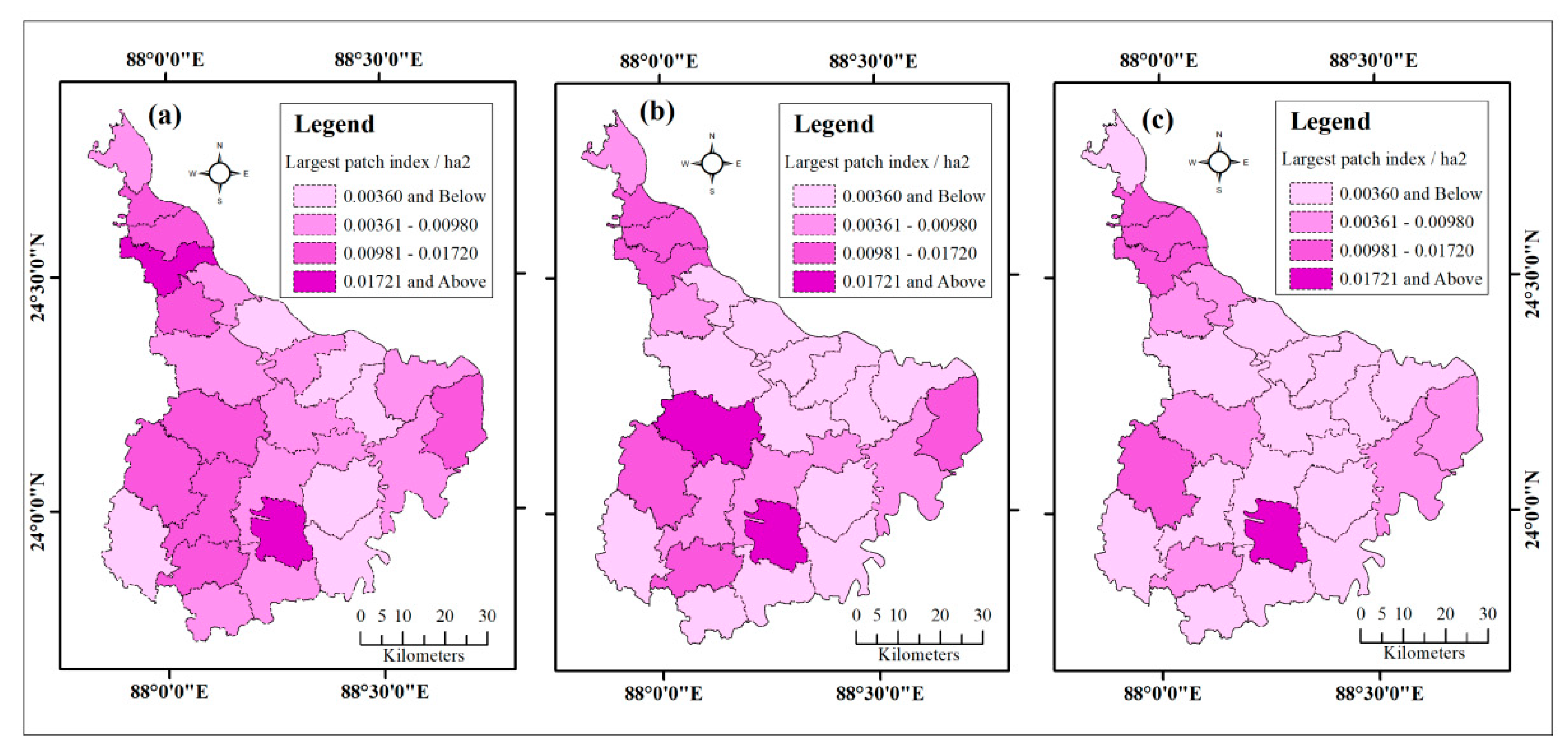

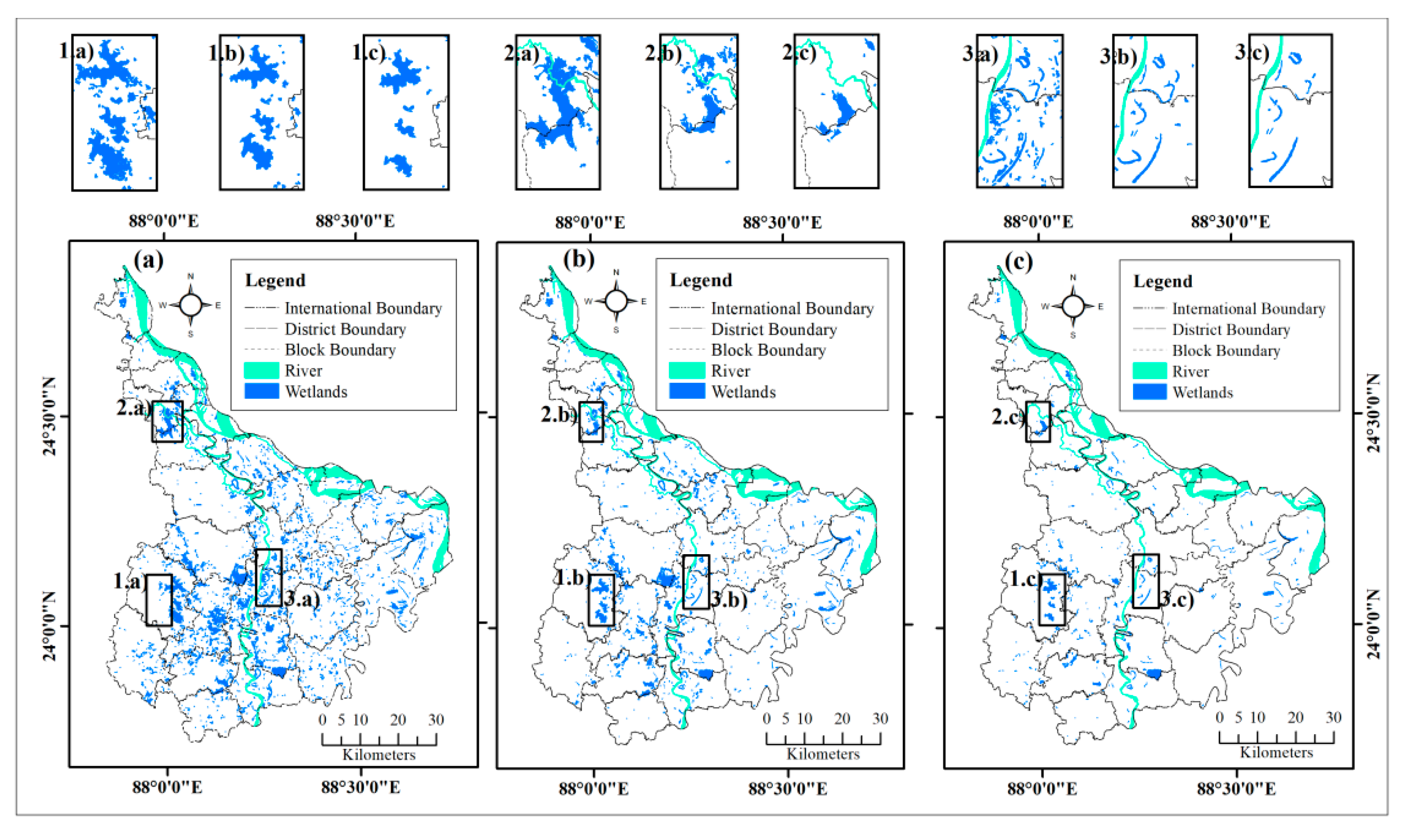
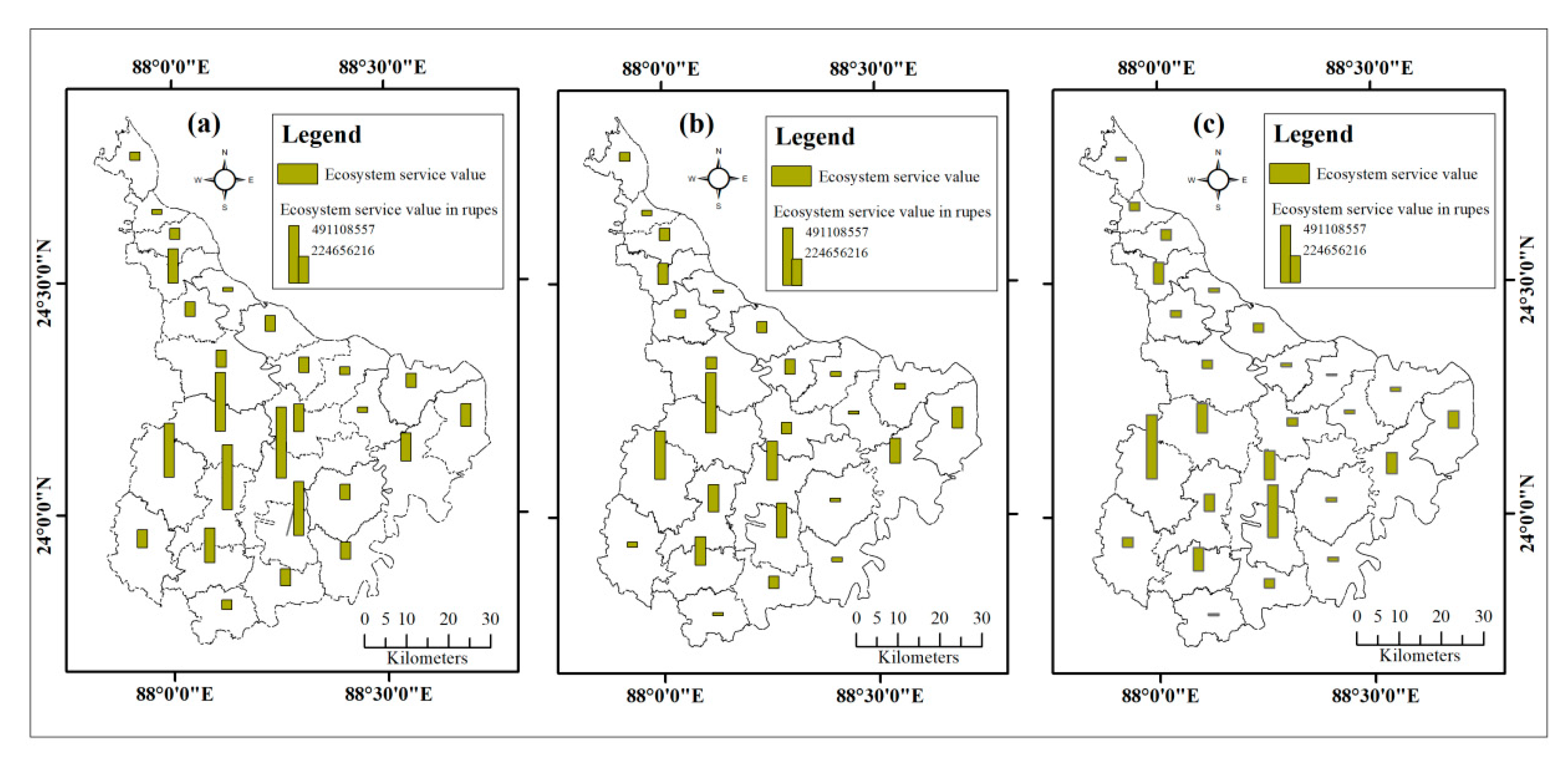
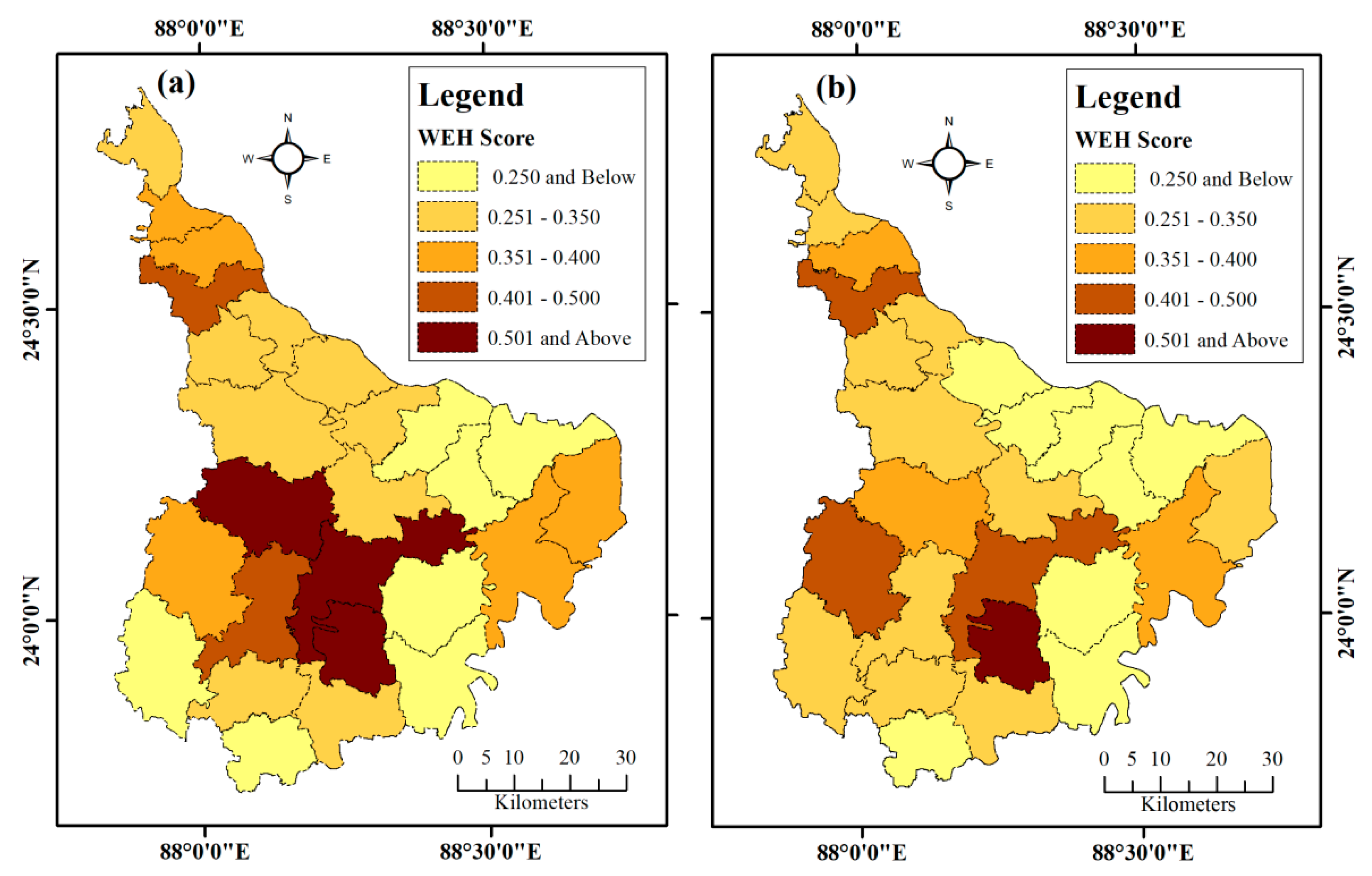
| Criteria | Indicator | Health-Related |
|---|---|---|
| Pressure | Population density | − |
| Road density | − | |
| Urbanization growth rate | − | |
| State | Patch richness | + |
| Patch density | + | |
| Largest patch index | + | |
| Landscape diversity index | + | |
| Response | Wetland degradation rate | + |
| Ecosystem service value | + |
| Higher-Level Indicator | Lower-Level Indicator | Correlation Matrix | Priority | Weight | |||
|---|---|---|---|---|---|---|---|
| A | B | C | D | ||||
| Wetland ecosystem health | A. Pressure | 1 | 1/3 | 3 | 0.2580 | ||
| B. State | 3 | 1 | 5 | 0.6370 | |||
| C. Response | 1/3 | 1/5 | 1 | 0.1050 | |||
| Pressure | A. Population density | 1 | 3 | 5 | 0.6480 | 0.1437 | |
| B. Road density | 1/3 | 1 | 2 | 0.2300 | 0.1016 | ||
| C. Urbanization growth rate | 1/5 | 1/2 | 1 | 0.1222 | 0.0823 | ||
| State | A. Largest patch index | 1 | 1/3 | 2 | 5 | 0.2390 | 0.1215 |
| B. Patch density | 3 | 1 | 5 | 7 | 0.5740 | 0.1783 | |
| C. Patch richness | 1/2 | 1/5 | 1 | 3 | 0.1310 | 0.0930 | |
| D. Shannon diversity index | 1/5 | 1/7 | 1/3 | 1 | 0.0560 | 0.0634 | |
| Response | A. Wetland degradation rate | 1 | 5 | 0.8330 | 0.1272 | ||
| B. Ecosystem service value | 1/5 | 1 | 0.1670 | 0.0889 | |||
| Year | 2001 | 2013 | 2020 |
|---|---|---|---|
| Wetland area (ha) | 28,069.39 | 15,520.24 | 6594.15 |
| Percentage of wetland area | 5.32 | 2.94 | 1.25 |
| WEH Score | Health Strata | Status of Health |
|---|---|---|
| 0.501–1.00 | Very healthy | Wetland landscape with sustainable and stable system, very healthy ecosystem functions with minimal external pressure |
| 0.401–0.50 | Healthy | Wetland landscape with sustainable and stable system, healthy ecosystem functions with less external pressure |
| 0.351–0.40 | Sub-healthy | Wetland maintains basis system with some changes of landscape, degraded ecosystem functions and greater external pressure |
| 0.251–0.35 | Unhealthy | Wetland landscape is a degraded system with a broken landscape, unhealthy ecosystem functions and relatively greater external pressure |
| 0.00–0.250 | Sick | Wetland landscape is a seriously degraded system with a completely destroyed landscape, sick ecosystem functions and very high external pressure |
| WEH Score | Health Category | 2013 | 2020 | ||
|---|---|---|---|---|---|
| No. of Block | % | No. of Block | % | ||
| 0.501–1.00 | Very healthy | 3 | 11.54 | 1 | 3.85 |
| 0.401–0.50 | Healthy | 2 | 7.69 | 3 | 11.54 |
| 0.351–0.40 | Sub-healthy | 5 | 19.23 | 3 | 11.54 |
| 0.251–0.35 | Unhealthy | 9 | 34.62 | 11 | 42.31 |
| 0.00–0.250 | Sick | 7 | 26.92 | 8 | 30.77 |
© 2020 by the authors. Licensee MDPI, Basel, Switzerland. This article is an open access article distributed under the terms and conditions of the Creative Commons Attribution (CC BY) license (http://creativecommons.org/licenses/by/4.0/).
Share and Cite
Das, S.; Pradhan, B.; Shit, P.K.; Alamri, A.M. Assessment of Wetland Ecosystem Health Using the Pressure–State–Response (PSR) Model: A Case Study of Mursidabad District of West Bengal (India). Sustainability 2020, 12, 5932. https://doi.org/10.3390/su12155932
Das S, Pradhan B, Shit PK, Alamri AM. Assessment of Wetland Ecosystem Health Using the Pressure–State–Response (PSR) Model: A Case Study of Mursidabad District of West Bengal (India). Sustainability. 2020; 12(15):5932. https://doi.org/10.3390/su12155932
Chicago/Turabian StyleDas, Subhasis, Biswajeet Pradhan, Pravat Kumar Shit, and Abdullah M. Alamri. 2020. "Assessment of Wetland Ecosystem Health Using the Pressure–State–Response (PSR) Model: A Case Study of Mursidabad District of West Bengal (India)" Sustainability 12, no. 15: 5932. https://doi.org/10.3390/su12155932







